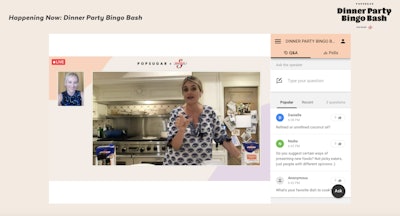
Adam Sloyer is the CEO of Sequence, an award-winning events agency specializing in production, strategic planning, and design. Sequence works with global brands and nonprofits producing virtual, hybrid, and in-person events.
 Adam Sloyer, CEO of SequencePhoto: Courtesy of Sequence
Adam Sloyer, CEO of SequencePhoto: Courtesy of Sequence
1. Start with the "why."
Just like you would with an in-person event, start with why you’re hosting the virtual event in the first place. Determine the goals and the KPIs, and let those indicators drive decision-making about what your event should and shouldn’t be.
2. Host a virtual event—not a webinar.
In order for any event to be successful, engagement is paramount. And in order to facilitate engagement, the experience needs to be dynamic and interaction needs to be a two-way street. There’s nothing wrong with presenters sharing content on Zoom, but that in and of itself does not constitute a virtual event. To create a truly successful experience, look for ways to optimize interaction for your attendees (beyond a chat window, if possible!).
3. Keep an eye on the clock.
Just because your in-person event program was two hours doesn’t mean your virtual program should be. Err on the side of brevity, because it is way too easy to lose your attendees’ attention in a virtual event. If you’re hosting an event after-hours or on a weekend, attention conflicts are going to be even more significant. Also to consider, your virtual event may not be bound to similar time constraints as your in-person experience. If your in-person event was previously a full, single day, consider breaking virtual content up into smaller, more consumable chunks for easier consumption.
4. Identify the right broadcast style.
Streaming live content can ensure there’s no confusion over whether an event is happening in real time. Speakers can respond to or factor in the most current events, and can most easily engage with attendees. On the other hand, live content also increases the possibility of technical and/or speaker miscues. Prerecording is far safer, but you run the risk of outdated content, and too much prerecord can feel like a content share instead of an event. For most events, the answer to broadcast style is usually some mix between the two—but the best course of action is to let your event goals, content, stakeholders, and attendees dictate the path forward.
5. Don’t shortchange the rehearsal time.
One of the biggest differences between in-person and virtual events is the prep time needed by speakers. Whether your content is live or prerecorded, you’ll need time to run through tech tests and rehearsals. For those speaking live, you’ll need to ensure there’s comfort with the streaming platform, clear contingency plans, and likely significantly more time on the day-of than what you allocated for in-person rehearsals. The bottom line is that virtual events require more upfront time from speakers, not less!
6. Don’t shortchange the planning time, either.
You likely wouldn’t start planning your in-person conference, activation, or gala a month before the event, so don’t rush through the planning of your virtual event either. Virtual experiences can have just as many nuances as in-person, so ensure you leave yourself enough time to focus on both big-picture strategy and the details.
7. Good technical production doesn’t have to be costly.
Sure, you can spend top dollar to rent out a production studio and have first-class sound, lighting, and video. But with some simple steps, you can also optimize a home setup, including adding some basic (and inexpensive) equipment that can go a long way. Green screens and elaborate backdrops can provide a "wow," but getting a peek into speakers’ homes or work environments can sometimes be more personal, authentic, and cost-effective.
8. Think outside the screen.
Your virtual event is going to be rooted in digital, but that doesn’t mean it has to be exclusively so. Experiences are best when they’re multi-sensory, so when budget allows, consider adding elements like food and drink, swag, a printed piece, or some other physical touchpoint that ties into your event and adds another dimension.
9. Think inside the screen.
Physical touchpoint or not, your attendees will be spending the majority of their time in front of the screen. So prioritize branding, graphics (including motion graphics), and videos. Invest in the visuals because, ultimately, without an actual event space, they are both your design and your environment.
10. Embrace the virtues of virtual.
No one will argue that there are clear and distinct benefits of in-person experiences that virtual events cannot replace. However, there are also unique advantages to virtual. Whether it’s reaching a broader audience, creative sponsor engagement, or integrating headline speakers without having to fulfill lengthy riders, leverage the opportunities that virtual affords you that in-person events might not. Use it as an opportunity to take a chance or try something new, and you might be surprised that the results are better than you expected.



















